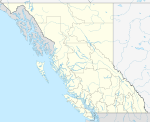District municipality
A district municipality is a designation for a class of municipalities found in several locations, including Canada, Lithuania, and South Africa.
Canada
British Columbia
Under provincial law, municipalities in British Columbia are to be designated "district municipalities" on incorporation if the area to be incorporated is greater than 800 hectares (8 km²) and has an average population density of less than 5 persons per hectare (500 persons per km²).[1] Municipalities may be incorporated under different classifications under the direction of the Lieutenant Governor in Council, as is the case with the District of North Vancouver.
Nova Scotia
In Nova Scotia, a district municipality is one of four municipal status types.[2] District municipalities and county municipalities are further considered rural municipalities.[3] The province's twelve district municipalities were created in 1879 from six historical counties.[3] They are referred to as municipal districts by Statistics Canada.[4]
Ontario
Currently, only one district municipality exists in Ontario – District Municipality of Muskoka. It was formerly a district but has undergone heavy urbanization and development, particularly from tourism, as it is the heart of Ontario's cottage country. As a result, it was "upgraded" from a district (such as neighbouring Parry Sound District) to having powers similar to a regional municipality, such as York Regional Municipality.
South Africa
In South Africa, district municipalities are administrative divisions of a province. South Africa recognizes three types of municipality; metropolitan, district and local. District municipalities are made up of a number of local municipalities. The vast majority of land consists of district municipalities, with metropolitan municipalities being reserved for large cities and the areas around them. There are eight metropolitan municipalities, and 44 district municipalities subdivided into 226 local municipalities.
References
- "Local Government Act (RSBC 1996) CHAPTER 323". Queen's Printer (British Columbia). Archived from the original on 2007-07-08. Retrieved 2007-07-26.
- "Municipal Government Act" (PDF). Office of the Legislative Counsel, Nova Scotia House of Assembly. June 19, 2012. p. 16. Retrieved January 9, 2017.
(aw) "municipality" means a regional municipality, town or county or district municipality, except where the context otherwise requires or as otherwise defined in this Act;
- "The Establishment of Elective Rural Municipal Government in Nova Scotia" (PDF). Government of Nova Scotia: Department of Municipal Affairs. pp. 1, 2. Retrieved January 9, 2017.
- "Interim List of Changes to Municipal Boundaries, Status, and Names: From January 2, 2014 to January 1, 2015 (Table A: Census subdivision types by province and territory, as of January 1, 2015)". Statistics Canada. Retrieved January 9, 2017.
